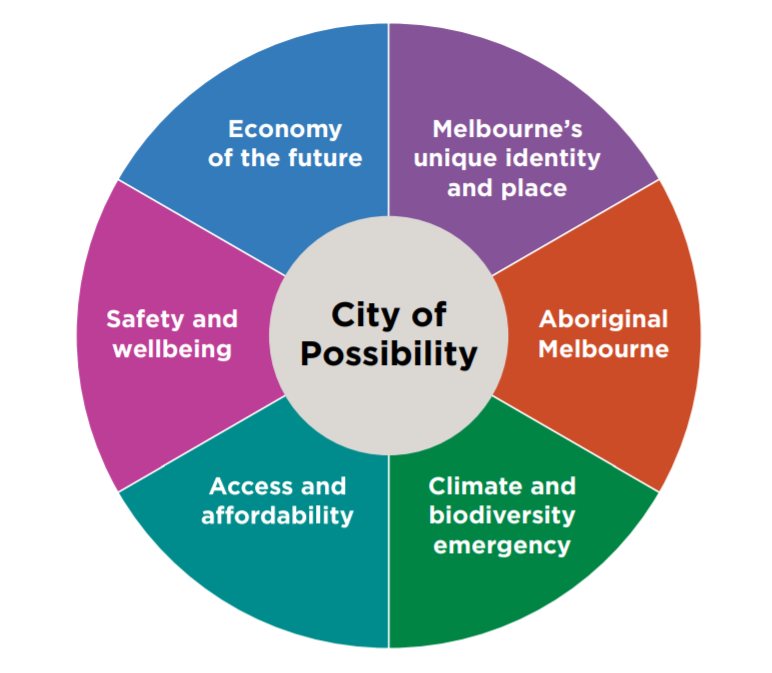Community connection
- Read fill-in-the-blanks postcards.
- Explore the community wall.
If viewing on mobile, hold and swipe tabs left to view all.
Check out what others have shared below about East Melbourne’s assets and strengths.
We asked:
East Melbourne is an established area to the east of the central city, home to many 19th century homes, iconic landmarks and the heritage listed Fitzroy, Treasury and Parliament gardens.
Parliament House, the Old Treasury Building and St Patrick’s Cathedral are located in the west of the neighbourhood. To the south, East Melbourne encompasses Melbourne’s Sports and Entertainment Precinct, including Melbourne Park, AAMI Park and the world-famous Melbourne Cricket Ground.
Terrace housing is common in East Melbourne’s leafy streets, alongside remnant mansions, some of which are listed on the Victorian Heritage Register, and a growing number of residential apartment developments.
East Melbourne has a large health services industry with many medical practitioners locating in the area due to its proximity to local hospitals, including The Royal Victorian Eye and Ear Hospital, Freemasons Hospital and Peter MacCallum Cancer Institute.
Data is sourced from 2021 Australian Bureau of Statistics (ABS) Census of Population and Housing, ABS Estimated Resident Population 2021, and 2020 Census of Land and Employment (CLUE).
To access more data on East Melbourne, visit: East Melbourne community profile on profile .id.
To learn more about the ABS Census of Population and Housing, including definitions, visit: Guide to Census data.
The City of Melbourne owns the Powlett Reserve Children’s Centre, which is operated by a Committee of Management. This centre provides a 51-place education and care centre with integrated kindergarten.
The East Melbourne Library loans of books and other materials for 1,700 members. This year we will purchase approximately 2,800 new books. We have bookable spaces at the library for community use, a local history room and service, computer access with 24-hour Wi-Fi and programs for children, teenagers and adults.
We also manage Cook’s Cottage, the Visitor Information Centre and the Pavilion in Fitzroy Gardens.
We manage and maintain many public spaces across East Melbourne including Burston Reserve, Birrarung Marr, Darling Square, Fitzroy Gardens, Giliot Reserve, Gordon Reserve, Treasury Gardens, Gosch’s Paddock, Jolimont Reserve, Parliament Gardens, Powlett Reserve, Royal Australasian College of Surgeons, St Andrews Place Reserve, Stapley Parade Reserve, Weedon Reserve and Wellington Park.
Powlett Reserve Tennis Centre is leased to Victoria Tennis Academy, a five-court facility catering for a range of community tennis programs, coaching and public court access.
See the ideas forum.
Seven initiatives represent our city’s plan for reactivation and recovery following the COVID-19 pandemic. Together, they connect our immediate response to the crisis with our city’s longer-term regeneration. By linking the actions that we take in the short-term with the outcomes we want to see in the future, we can ensure that we target our resources to those initiatives that best meet our long term strategic objectives and ultimately deliver maximum benefit for our city and its citizens.
Read the full consultation recap.
The COVID-19 Reactivation and Recovery Plan integrates with the Council planning framework and City of Melbourne’s strategic plans and is designed to help guide and shape our work now and into the future.
Read the COVID-19 Reactivation and Recovery Plan.
We spoke with more than 750 people who live, work, study, visit or own a business in the municipality to understand what our community values most about the city.
Overall, the community’s top aspirations were for Melbourne to be a city that:
Read the full consultation recap.
The community’s feedback was gathered and synthesised into a series of insights and aspirations that helped to create the 10-year Community Vision and four-year Council Plan.
Read the Consultation Report (PDF 1.06MB).
Six strategic directions from the Council Plan include:

New infrastructure investments in East Melbourne this year include:
We will invest $2,719,500 on renewal works in East Melbourne including for roadways, kerb and channel, parks, landscape, library collection and property.
We will invest $285,692 on maintenance works in East Melbourne on community facilities and other property, pedestrian infrastructure and for urban forest health.
This year we will:
We will progress delivery of: